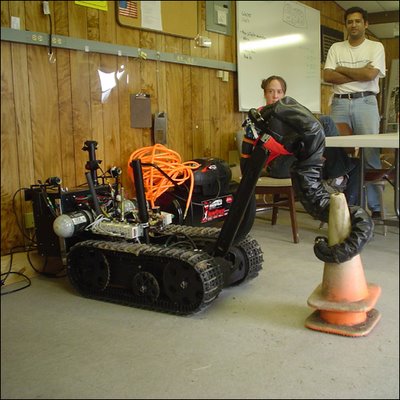By Tracy Staedter, Discovery News
May 22, 2006
A robot with a flexible, trunk-like arm could one day work like an elephant to grasp unwieldy loads, navigate like a snake through the rubble of a disaster zone, or feel around inside the dark crevasses of other planets.
Unlike conventional robots with rigid joints -- picture a crane-like appendage with a claw-shaped hand -- the OctArm's nimble design allows it to move freely and adapt to its surroundings.
"These robots are invertebrate robots and are good at getting into tight spaces and wriggling around," said Ian Walker, a professor of electrical and computer engineering, whose team at Clemson University in South Carolina has been working on the project for nearly 10 years.
Conventional robots work best when tasked with a predictable job in a structured setting, such as a factory assembly line. But in the unpredictable, unstructured environment of a disaster zone or the surface of a distant planet, a more flexible robot is needed.
Walker and a team of researchers from eight institutions in the United States and Israel built a strong, dexterous robotic arm that uses tubes pumped with compressed air to mimic the muscles that control tongues, trunks and tentacles.
A scientist uses a joystick to the control the OctArm, which resembles an elephant trunk: thick at the base and tapered toward the tip. A computer responds to the joystick's motions by changing the air pressure inside individual tubes.
For example, to move the OctArm from the extended position into a coiled shape, air pressure must be increased in the tubes on the side of the arm facing up. Simultaneously, air pressure decreases in the tubes on the downward-facing side of the arm.
The force of increased air pressure on one side of the arm pulls it into the coiled position. To extend it again, the scientists apply air pressure in the reverse way.
More complicated motions, such as curling around an object and lifting, require more sophisticated computer algorithms. Developing these algorithms is one of the bigger challenges facing Walker and his team.
In field tests, the OctArm successfully grasped balls and pieces of wood -- even clinging to them -- while submerged in rushing water.
"The OctArms are not precise or positional, but they are compliant and flexible and can conform to crazy shapes and do some things that traditional robots can't," said Shane Farritor, associate professor ofmechanical engineering at the University of Nebraska-Lincoln.
This summer, Walker and his team will be working improve the OctArm's precision, adding sensors and a camera.
[from Discovery Channel News]

No comments:
Post a Comment